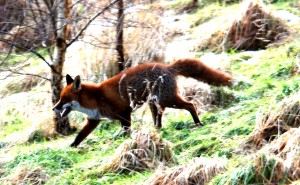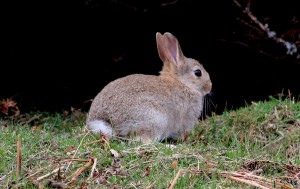 Wildlife sounds as a background to programmes on the television vary considerably but for night scenes the commonest are the fox and tawny owl. The fox is top of the list, mainly the barking calls, screams or shrieks that are mainly the dog fox or, occasionally, the scream of the vixen which is mainly when she is actually mating. The number of times you will hear such calls on the television must give the impression that there are foxes everywhere from urban areas to the wildest of countryside such as in parts of the Highlands. In fact they are widespread and common, although uncommon in parts of the Highlands, but seeing them is another matter and it is fair to say they are, in many ways, the most secretive of animals. For example, in the 28 years of living in a strath near Inverness the number of foxes I have seen can be counted on one hand. I have seen badgers and pine martens, both, like the fox, termed as nocturnal, many times compared with the fox. In some places people feed foxes and they will come to food left out even in urban situations but they are still difficult to see in the general landscape whether it is urban or rural.
Wildlife sounds as a background to programmes on the television vary considerably but for night scenes the commonest are the fox and tawny owl. The fox is top of the list, mainly the barking calls, screams or shrieks that are mainly the dog fox or, occasionally, the scream of the vixen which is mainly when she is actually mating. The number of times you will hear such calls on the television must give the impression that there are foxes everywhere from urban areas to the wildest of countryside such as in parts of the Highlands. In fact they are widespread and common, although uncommon in parts of the Highlands, but seeing them is another matter and it is fair to say they are, in many ways, the most secretive of animals. For example, in the 28 years of living in a strath near Inverness the number of foxes I have seen can be counted on one hand. I have seen badgers and pine martens, both, like the fox, termed as nocturnal, many times compared with the fox. In some places people feed foxes and they will come to food left out even in urban situations but they are still difficult to see in the general landscape whether it is urban or rural.
 These days finding food is a major problem for the fox because one of its main sources has disappeared from many parts of the Highlands. This is the rabbit and whereas in the past they have been widespread, either as road casualties or in their sometimes large colonies, they have just gone. A good example was my drive to the Cairngorms last weekend. Whereas as there were road casualties that included many pheasants, two mountain hares and a roe der there was not a single dead rabbit. In the past rabbits would have been the commonest casualty. Indeed the only live rabbits I saw were two in a field near Tomatin.
These days finding food is a major problem for the fox because one of its main sources has disappeared from many parts of the Highlands. This is the rabbit and whereas in the past they have been widespread, either as road casualties or in their sometimes large colonies, they have just gone. A good example was my drive to the Cairngorms last weekend. Whereas as there were road casualties that included many pheasants, two mountain hares and a roe der there was not a single dead rabbit. In the past rabbits would have been the commonest casualty. Indeed the only live rabbits I saw were two in a field near Tomatin.
This has had a major impact on the fox who has had to seek an alternative food and in some cases this means having to raid domestic hens and ducks. In the past this had led to one of the many myths about the fox, and for that matter other mammals such as pine marten and stoat. When any of these raid domestic birds they will kill far more birds than they actually need at that time. I have lost Indian runner ducks to stoats and light Sussex hens to pine marten. The immediate response to finding large numbers of birds dead with only one or two part eaten or taken away is to think “lust killing”. In fact nothing could be further from the truth. All the predator is doing is to leave dead birds so it can come back for food at another time whether for itself or for its offspring. However, this does not compensate for finding the dead birds!
The den or earth of the fox is an important refuge and hiding place although it may only be used in the winter months. It is dug out by the vixen in well-drained soil. The soil is kicked out by her powerful back legs and may accumulate up to 2 metres away. There are several entrance holes up to 20 cms in diameter. I some ways they are like badger setts but the smell often gives away the foxes’ den. This comes for two sources, with one being the urine used to mark out territory, and the droppings. Also, unlike the badger, the fox leaves pieces of food, sometimes rotting, around the entrance holes.
Tags: highland wildlife
